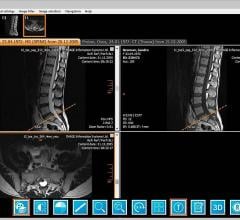If you enjoy this content, please share it with a colleague
Image Information Systems
RELATED CONTENT
December 8, 2021 — IMAGE Information Systems, headquartered in Rostock, Germany, and aycan Medical Systems ...
The implementation of electronic health records (EHR) has created an expectation that all patient data, including images, should be available in one location. Today, reports describing images are not enough, as many referring physicians want to see the images, and many use them to help guide therapies. This has caused an increased demand to exchange medical images in the various departments of healthcare settings.
Image Information Systems released version 3.0 of its iQ-VIEW radiology reading station in November and displayed it at the 2016 annual meeting of the Radiological Society of North America (RSNA) in Chicago.
Image Information Systems launched Med-Tab, the world’s first portable DICOM-calibrated medical image display, at the 2015 Radiological Society of North America (RSNA) annual meeting, Nov. 29-Dec. 3 in Chicago.
As the saying goes, sometimes less is more — a maxim that is proving true in the world of medical imaging as remote viewing systems continue to advance. While some manufacturers are still utilizing software-based systems for reading and sharing imaging data, many are embracing browser-based models, otherwise known as zero-footprint viewers.
Imaging is critical to all medical specialties so it is logical that images should be available to specialists outside of radiology. There is a trend to reduce repeat exams by making images more easily accessible, including prior exams. This traditionally has been accomplished using the cumbersome process of mailing or physically carrying CDs to referring physicians. Often these CDs do not open or take a long time to download. Stage 2 Meaningful Use requirements for certified electronic medical records (EMR) also call for the sharing of medical images electronically to help improve efficiency and reduce healthcare costs. All of these factors have given rise to remote image access systems.
Today’s digital picture archiving and communication systems (PACS) is highlighted with several choice words around the industry: accessible, flexible, Web-based, thin client versus thick client and vendor-neutral. Whatever term is used to describe the PACS of today and the future, one thing is clear: the aim now is to be able to store medical images, sourced from any modality, in a secure location on a network and retrieve them for review from any platform or any device.
Today’s remote viewing systems will stimulate changes and challenges in healthcare in a manner similar to what online banking has done for the financial industry. The areas of improvement include safe, secure, remote access from any browser, or ultimately any mobile device. This is the reality of today, and it comes without the need for special applications or image and associated data downloads from virtually any source.
June 20, 2012 — Image Information Systems has introduced its iQ-Launcher module as a free tool for its radiology workstation, iQ-View (versions 2.7 and above), to exchange DICOM (digital imaging and communications in medicine) and non-DICOM data bidirectionally between iQ-View and various measurement tools.


 December 08, 2021
December 08, 2021 


